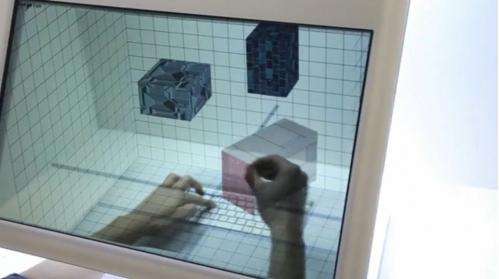February 27, 2013 report
TED SpaceTop presenter is redefining hands-on computing (w/ video)

(Phys.org)—Jinha Lee, an MIT graduate student, this week showed his SpaceTop, a desktop environment where you can "reach inside" a computer screen and manipulate objects as if they were real. Lee, who initially worked on the concept as an intern with Microsoft Applied Science, presented the SpaceTop at the TED conference. The project earlier on had been tagged at Microsoft as the 3-D See-Through Desktop.
The SpaceTop presented this week shows how users can type, click, and draw in 2-D, and directly manipulate interface elements that float in the 3-D space above the keyboard, according to Lee. SpaceTop makes it easy for a user to switch from one modality to another, or to simultaneously use two modalities with different hands.
In one scenario demonstrated by Lee, users can place their hands behind the screen to scroll or type as in traditional computers, and can directly manipulate display objects as well with their hands. SpaceTop enables bimanual interaction, where each hand is associated with an interaction of different fidelities, according to Lee. The user can use one hand to flip through a pile of documents while using another hand to specify a line in the main document. In other scenarios, users can prototype a model with free-form manipulation.
The buzz surrounding this computer interface, though in its early phase, is that of a concept stirring imaginations for what the next big things in interface experiences might be. Lee's stepping stone to the future is powered by an LED display. The system uses two cameras. One tracks the user's gestures. The other tracks the user's gaze and makes adjustments on what is displayed so that everything appears as correct. The ability to manipulate objects in a see-through scenario will not easily relate to all work tasks, but Lee said that his 3-D interaction could make sense for a number of use cases, such as collaboration, design, and even trying on virtual clothes.
Lee looks forward to users being able to freely experience a seamless work experience of transitioning regularly between 2-D and 3-D manipulations. Through the use of depth cameras and a transparent display, interaction modalities can occur in a unified workspace.
Lee, selected as a TED Fellow, has described his role as "an interaction designer and researcher working at the boundary of physical and digital world." His inventions include levitating tangible interfaces and a pen that reaches inside a screen.
A video presentation, "Integrating 2-D and spatial 3-D interactions in a see-through desktop environment," carries credits of the team involved in working on the see-through environment as shown in the video. Besides Lee are Alex Olwal, Hiroshi Ishii and Cati Boulanger. Olwal and Ishii are from the MIT Media Lab and Boulanger is from Microsoft Applied Science.
More information: www.leejinha.com/spacetop
© 2013 Phys.org





















